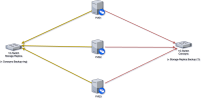Hey everyone,
after reading a lot and coming to the conclusion... Running a 2 node cluster productively with replicated storage (sync) is not feasible.
I have the possibility to build a hardware setup with 3 nodes as follows, whereby these are really the *maximum* possible hardware capacities. On this basis I *must* get a productive cluster up and running:
* 3 Proxmox nodes (each with NVMe SSDs in the ZFS RAIDZ2 network currently planned)
* Each node has 3 physical network cards (1x WAN / 2x LAN) with 1Gbit/s each
* The 3 nodes are connected to each other with a direct LAN connection
* PVE1 -> PVE2 ; PVE1 -> PVE3; PVE2 -> PVE3
My current plan is to run Corosync over the LAN (as previously planned with 2 nodes [Link]) only. Everything else, incl. Storage Replica goes via WAN.
The bare metals are in the same rack at the data center, so latency over WAN is less than 3ms.
The storage should be highly available.
Sync-Replica for all VMs would be ideal here... but I could also get along with using ZFS-Replica as a base (every 5 minutes) and additionally using mail server, DB, etc... with an additional 3 node Kubernetes + Longhorn cluster in VMs (1 Kubernetes node VM per Proxmox node, connected with VXLAN powered by Proxmox).
What are your thoughts, advice, suggestions? Or is this “not at all” possible?
I am very curious about your opinions and experiences and input for design decisions!
Many thanks in advance!
Kind regards, fr1000
//EDIT: I've searched trough the forum, but did not found a thread that matches my "special" network restrictions here.
after reading a lot and coming to the conclusion... Running a 2 node cluster productively with replicated storage (sync) is not feasible.
I have the possibility to build a hardware setup with 3 nodes as follows, whereby these are really the *maximum* possible hardware capacities. On this basis I *must* get a productive cluster up and running:
* 3 Proxmox nodes (each with NVMe SSDs in the ZFS RAIDZ2 network currently planned)
* Each node has 3 physical network cards (1x WAN / 2x LAN) with 1Gbit/s each
* The 3 nodes are connected to each other with a direct LAN connection
* PVE1 -> PVE2 ; PVE1 -> PVE3; PVE2 -> PVE3
My current plan is to run Corosync over the LAN (as previously planned with 2 nodes [Link]) only. Everything else, incl. Storage Replica goes via WAN.
The bare metals are in the same rack at the data center, so latency over WAN is less than 3ms.
The storage should be highly available.
Sync-Replica for all VMs would be ideal here... but I could also get along with using ZFS-Replica as a base (every 5 minutes) and additionally using mail server, DB, etc... with an additional 3 node Kubernetes + Longhorn cluster in VMs (1 Kubernetes node VM per Proxmox node, connected with VXLAN powered by Proxmox).
What are your thoughts, advice, suggestions? Or is this “not at all” possible?
I am very curious about your opinions and experiences and input for design decisions!
Many thanks in advance!
Kind regards, fr1000
//EDIT: I've searched trough the forum, but did not found a thread that matches my "special" network restrictions here.
Last edited:


